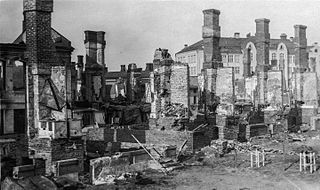
The Finnish Civil War was a civil war in Finland in 1918 fought for the leadership and control of the country between White Finland and the Finnish Socialist Workers' Republic during the country's transition from a grand duchy ruled by the Russian Empire to a fully independent state. The clashes took place in the context of the national, political, and social turmoil caused by World War I in Europe. The war was fought between the Red Guards, led by a section of the Social Democratic Party, and the White Guards, conducted by the senate and those who opposed socialism with assistance late in the war by the German Imperial Army at the request of the Finnish civil government. The paramilitary Red Guards, which were composed of industrial and agrarian workers, controlled the cities and industrial centres of southern Finland. The paramilitary White Guards, which consisted of land owners and those in the middle and upper classes, controlled rural central and northern Finland, and were led by General C. G. E. Mannerheim.
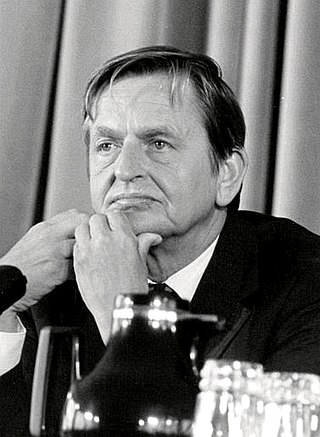
Sven Olof Joachim Palme was a Swedish politician and statesman who served as Prime Minister of Sweden from 1969 to 1976 and 1982 to 1986. Palme led the Swedish Social Democratic Party from 1969 until his assassination in 1986.

The Battle of Tampere was a 1918 Finnish Civil War battle, fought in Tampere, Finland from 15 March to 6 April between the Whites and the Reds. It is the most famous and the heaviest of all the Finnish Civil War battles. Today it is particularly remembered for its bloody aftermath as the Whites executed hundreds of capitulated Reds and took 11,000 prisoners placed in the Kalevankangas camp.

The Russo-Swedish War of 1495–1497, known in Sweden as the Stures' Russian War, was a border war which occurred between the Grand Duchy of Moscow and the Kingdom of Sweden. Although the war was relatively short, and did not lead to any territorial changes, it has significance as the first war between Sweden and Moscow. Sweden earlier fought wars against the Novgorod Republic, before Novgorod was formally annexed to Moscow in 1478.

Arvid Mörne was a Finnish author and poet. He was nominated for the Nobel Prize in Literature four times.

Jüri Vilms was a member of the Estonian Salvation Committee and the first Deputy Prime Minister of the Republic of Estonia. Empowered by Maapäev the Salvation Committee issued the Estonian Declaration of Independence on February 24, 1918 in the middle of a political power vacuum created by the retreating Russian and advancing German troops during World War I. The German forces taking over the country didn't recognize the independence of Estonia. The Salvation Committee went underground, Jüri Vilms volunteered to go to Finland to take funds and instructions to the Estonian missions working to get diplomatic recognition for the newly sovereign nation. According to an "official" version, he was captured on reaching the Finnish coast and executed by German troops in Helsinki. According to the latest research Jüri Vilms may have been executed by a unit of the Swedish Brigade in Hauho. Estonia gained its independence after the German troops were withdrawn from Estonia due to the German Revolution and following Estonian War of Independence ended with Peace Treaty of Tartu.
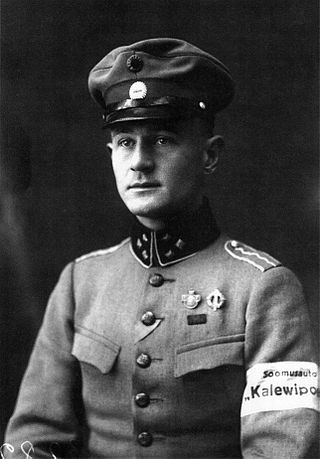
Einar Paul Albert Muni Lundborg was a Swedish aviator.
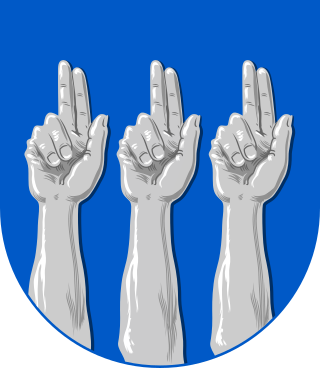
Anjala was a town in Southern Finland, which merged in 1975 with Sippola to form Anjalankoski, later further merged into Kouvola.

Christian Palme is a Swedish communications expert, journalist and writer. He is a son of the late historian, professor Sven Ulric Palme and brother of professor emeritus Jacob Palme. His grandfather was the historian Olof Palme (1884–1918), and his great-grandmother was Swedish-speaking Finnish women's rights activist Hanna Palme.

The Whites, or White Finland, is the name used to refer to the refugee government and those forces who fought for and under Pehr Evind Svinhufvud's first senate, who were opposed the "Reds", or the Finnish Socialist Workers' Republic, during the Finnish Civil War or the 'Finnish War of Independence', as it is often called by the Whites, in 1918.
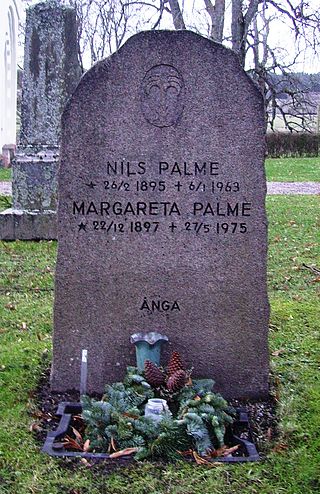
Nils Palme was a Swedish military officer and landowner.

Olof Palme was a Swedish historian and one of the organizers of the voluntary Swedish Brigade, which fought for the Whites during the 1918 Finnish Civil War. He was the uncle of Olof Palme, the prime minister of Sweden, who was murdered in 1986.
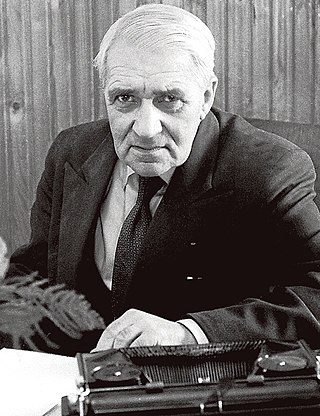
Gunnar Olof Björling, was a Swedish-speaking Finnish poet. He was one of the leading figures of Finnish-Swedish modernist literature, along with Elmer Diktonius, Edith Södergran and Hagar Olsson.

The Battle of Länkipohja was a Finnish Civil War battle fought in the village of Länkipohja on 16 March 1918 between the Whites and the Reds. Together with the battles fought in Kuru, Ruovesi and Vilppula between 15 and 18 March, the Battle of Länkipohja was one of the first military operations related to the Battle of Tampere, which was the decisive battle of the Finnish Civil War. The battle is known for its bloody aftermath as the Whites executed 70–100 capitulated Reds. One of the executions was photographed and the images have become one of the best known pictures of the Finnish Civil War.

August Anselm Wesley was a Finnish journalist, trade unionist, and revolutionary who was the chief of the Red Guards general staff in the Finnish Civil War. He later served as a lieutenant in the British organized Murmansk Legion and the Estonian Army.

The Pohjois-Haaga mass grave is a grave in Lassila, Helsinki, Finland, near the Pohjois-Haaga railway station that dates to the time of the Finnish Civil War in 1918. 28 men of the Red Guards or civilians thought to have been affiliated with them executed by the German Baltic Sea Division soldiers are buried at the site.
The Haaga executions of 1918 took place in Etelä-Haaga in what was then the Rural Municipality of Helsinge during the Battle of Helsinki of the Finnish Civil War on 12 April 1918. A total of 45 persons suspected of belonging to the Red Guards were executed by German troops at a bog at 8 o’clock p.m. at the site of the present Eliel Saarisen tie, halfway from the Pitäjänmäki roundabout to the tunnel leading to the Huopalahti Station, at the site of a pedestrian crossing. 28 of those executed were buried in the Pohjois-Haaga mass grave, which is located close to the current Pohjois-Haaga railway station.
Stig Folke Wilhelm Engström was a Swedish graphic designer. Long treated by police as an eyewitness to the assassination of Prime Minister Olof Palme, Engström was separately proposed as Palme's assassin by the Swedish writers Lars Larsson and Thomas Pettersson.

Arvi Kalsta was a Finnish Jaeger captain, the founder of the Nazi Finnish People's Organisation and a businessman. In the 1930s, the Finnish Nazis who belonged to his supporters were called Kalstaites.

Harald Ossian Hjalmarson was a Swedish soldier who volunteered for the Finnish Civil War in 1918 on the white army. He served as the commander of Hjalmarson's group, the Crenatorial Division, which belonged to the Western Army. At the Finnish White Headquarters, his actions during the war were unsatisfactory and he was not popular among the ranks. Hjalmarson received the rank of Major General in the Finnish Army, but in the Swedish Army he was only a lieutenant colonel.



















